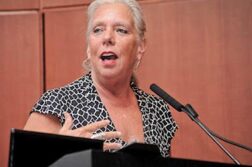There were far too many deaths in our community of arts, letters, and politics in late 2004 and in 2005. Herewith is our annual tribute.
Leroy F. Aarons, the founder and first president of the National Lesbian and Gay Journalists Association (NLGJA), died of cancer at the age of seventy on November 28, 2004. He was a pioneer in combating ethnic and sexual discrimination in journalism, and he had worked for The Washington Post and The Oakland Tribune, where he was a news executive. His book, Prayers for Bobby : A Mother’s Coming to Terms with the Suicide of Her Gay Son (1995) had its roots in an article Aarons had read in the San Francisco Examiner in 1989. Aarons, who also wrote the libretto for the opera Monticello, is survived by his partner of 24 years, Joshua Boneh.
David Brudnoy, Boston-based radio talk show host extraordinaire, a self-described libertarian and conservative on many issues, died of cancer at age 64 on December 9, 2004, leaving behind a legion of listeners and friends of all political persuasions. His memoir, Life Is Not a Rehearsal (1997) details how he was forced out of the closet upon being diagnosed with AIDS. Brudnoy wrote for The New York Times and a number of national magazines, and was also a movie reviewer. Though he leaves no immediate survivors, he was a cousin of Sharon Isbin, the openly lesbian classical guitarist.
Al Carmines, a leader in the inception of Off Off Broadway, winner of five Obie awards, died at age 69 on August 9, 2005. He had suffered from complications of an aneurysm. As Michael Bronski has noted, it was Carmines’ gay sensibility and style “that literally redefined and reinvented American theater.” An ordained Protestant minister, he began by turning the sanctuary of Judson Memorial Church into an avant-garde stage. Carmines was a leader in challenging what the New York Times called “the commercialization and conformity of Broadway and Off Broadway houses.” He composed over 80 musicals, one of which, In Circles, was based on the works of Gertrude Stein; he wrote and performed a different opening song each night. He is survived by his partner, Paul Rounsaville.
Molly Malone Cook, the second photographer hired by The Village Voice, died of cancer on August 26, 2005, at age eighty. In the 1950’s, she opened the VII Photographers’ Studio in Provincetown, where she represented such photographers as Berenice Abbott, Edward Steichen, and Eugene Atget, and she was the owner of the East End Bookshop, where John Waters once worked. Cook was also Norman Mailer’s assistant in the 1970’s and at that time ran her own literary agency. She leaves her partner of over forty years, poet Mary Oliver.
Robert Davolt, who in the 1990’s was editor and publisher of now-defunct Drummer magazine, died of cancer at age 46 on May 16, 2005. A prominent member of the leather community, he wrote Painfully Obvious: An Irreverent and Unauthorized Manual for Leather S/M (2004), a collection of nonfiction essays. He is survived by his partner, Joe Granese.
Andrea Dworkin died on April 9, 2005, at age 58, after years of fighting a number of chronic illnesses. She was a highly controversial crusader against pornography and was the author of over a dozen books. In Woman Hating (1976), her first book, she laid out her opposition to all forms of pornography as intrinsically violent against women. She was, as the Times observed, even “critical of consensual sex between women and men.” In Letters from a War Zone (1989) she wrote that heterosexual marriage was “a legal license to rape.” Her memoir, Heartbreak: the Political Memoir of a Feminist Militant was published in 2004. Although she publicly identified as a lesbian, she lived for three decades with and had in recent years married John Stoltenberg, managing editor of the AARP’s magazine.
Joseph Hansen died on November 24, 2004, at age 81, of heart failure. A prolific novelist, he wrote under the name of James Colton early in his career. Fadeout (1970), his first mystery, introduced a gay detective, Dave Brandstetter, a landmark at the time. Hansen is quoted as having said (in 1998) that he chose to “take the true hard-boiled character in American fiction tradition and make him homosexual. He was going to be a nice man, a good man, and he was going to do his job well.” He began his writing career as a poet, and was published in The New Yorker. Politically active all his life, Hansen was friends or lovers with many of the early movers and shakers in Gay Liberation, and helped found the Homosexual Information Center in 1968. A bisexual, Hansen and his bisexual wife were married for over a half century. He is survived by his daughter, who has had gender reassignment surgery.
Philip Johnson died at age 98 on January 25, 2005. The “most famous and controversial American architect of our time” (Boston Globe), it would be hard to overstate Johnson’s importance. He designed about 100 works, ranging from MoMa’s sculpture garden to the theaters at both Lincoln Center and the Kennedy Center for the Performing Arts, to the Cathedral of Hope in Dallas, the largest gay and lesbian church in the world. He served as curator of MoMa’s architectural exhibits. In the 1930’s and 1940’s, he became enthralled by Hitler but in his later years deeply regretted this. He was the author of numerous books on architecture and was the first winner of the Pritzker Prize. Johnson and was featured on the cover of Time magazine in 1979. He is survived by his partner of 45 years, David Whitney.
Gavin Lambert died at age eighty of pulmonary fibrosis on July 17, 2005. Prolific screenwriter, novelist, biographer, and editor of Sight & Sound magazine, he adapted Tennessee William’s The Roman Spring of Mrs. Stone to the screen and was nominated for an Oscar for his adaptation of Sons and Lovers. Born in England, he attended college there and, in 1942, was rejected for military service because he was gay. He became a U.S. citizen in 1964 and was a close friend of playwright Mart Crowley for forty years.
Jack Nichols, a gay activist a decade before the Stonewall Riots, died on May 2, 2005, of leukemia, at age 67. Nichols co-founded the Mattachine Society with Frank Kameny in 1961 in Washington, D.C., adopting the name of the organization founded by Harry Hay in 1950. Nichols was founder of the magazine Gay, the first gay weekly newspaper in the U.S., and for many years he edited GayToday.com. He led the first gay rights march on the White House, in 1965, and was in the forefront of convincing the American Psychiatric Association to remove its definition of homosexuality as a mental illness, which they did in 1973. Nichols’s memoir, The Tomcat Chronicles: Erotic Adventures of a Gay Liberation Pioneer, came out in 2004.
Jean O’Leary died on June 4, 2005, of lung cancer, at age 57. At one time a nun, she became a lesbian activist and organized the first White House meeting of gay leaders. She left the Gay Activists Alliance due to its male domination, and helped form the group called Lesbian Feminist Liberation. Later, she became co-executive director of the National Gay & Lesbian Task Force, and also helped establish the first National Coming Out Day in 1988. Her life story is recounted in a much-discussed chapter in Rosemary Curb and Nancy Manahan’s Lesbian Nuns: Breaking Silence (1985). She is survived by her partner, Lisa Phelps.
Theodore Sarbin died on August 31, 2005 at age 94 of pancreatic cancer. He was a social psychologist who co-wrote a 1988 Pentagon report, “Nonconforming Sexual Orientations and Military Suitability,” recommending cessation of discrimination against gays and lesbians in the U. S. military. He had taught psychology and criminology at U.C.–Santa Cruz. Sarbin rode the rails as a hobo during the Depression, going on to earn a doctorate from Ohio State University. He is survived by a female companion, children, and grandchildren.
Tobias Schneebaum died on September 20, 2005, of complications from Parkinson’s disease. An artist, his exact age was unknown, but he was in his eighties. His memoir, Keep the River on your Right (1969) brought him to prominence. In the words of The New York Times, it described “how a mild-mannered gay New York artist wound up living, and ardently loving, for several months among the Arakmbut, an indigenous cannibalistic people in the rainforest of Peru.” A 1955 Fulbright fellowship to study art in Peru led to his adventures. Schneebaum wrote a number of other memoirs. He was the subject of a 2002 documentary, Keep the River on Your Right: A Modern Cannibal Tale.
Susan Sontag died on December 28, 2004, of breast cancer, at age 71. One of the leading intellectuals of contemporary America, she was also the subject of controversy, ranging from her alliance with communism (which she later repudiated) after a trip to Hanoi in 1968, to her criticism of U.S. foreign policy after 9/11. Her “Notes on Camp” (published in Partisan Review in 1964) established her reputation as a critic of popular culture; Illness as a Metaphor (1978) examined the role of disease in culture; On Photography (1977) probed the connection between photos and their subject matter. She wrote award-winning novels and was a filmmaker, director, essayist, critic, and playwright. In a 1995 New Yorker profile, she outed herself as bisexual, and she’s reported to have had several relationships with women.
Lisa Stocker died on January 11, 2005 at age fifty. She was run down by a van near her home in New York. Her first novel, P-town Summer (2003), was a light-hearted depiction of four lesbians and their adventures during a week’s outing in Prov-incetown. Stocker worked for Time, Inc., and was working on her second novel. She is survived by her partner of 25 years, JoAnn Ambrosino.
LeRoy Whitfield died October 9, 2005, at age 36, of complications from AIDS. He had refused to take medication for the fifteen years that he’d lived with HIV, though near the end of his life he began to regret his decision. He was a journalist and contributor to a number of magazines, including Vibe, Positively Aware, and HIV Plus. He was a senior editor at POZ magazine. He was openly bisexual. Keith Boykin is quoted as saying that “he was unusually committed to exposing the truth about AIDS in the black community, and he was unafraid to challenge conventional wisdom.”
Sources consulted: The New York Times, The Chicago Sun-Times, The Advocate, Bay Windows, The New York Blade, The Boston Globe, The Provincetown Banner, In Newsweekly, Lesbian Connection, www.cathedralofhope.com, www.latimes.com, The Lambda Book Report, The New York Daily News, and www.keithboykin.com.




